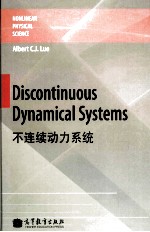

不连续动力系统 英文版PDF电子书下载
- 电子书积分:19 积分如何计算积分?
- 作 者:罗朝俊著
- 出 版 社:北京:高等教育出版社
- 出版年份:2011
- ISBN:9787040319576
- 页数:692 页
Chapter 1 Introduction 1
1.1.A brief history 2
1.2.Book layout 3
References 6
Chapter 2 Introduction to Flow Passability 9
2.1.Domain accessibility 9
2.2.Discontinuous dynamical systems 11
2.3.Flow passability 12
2.4.Grazing flows 22
2.5.Switching bifurcations of passable flows 31
2.6.Switching bifurcations of non-passable flows 44
2.7.An application:A frictional oscillator 56
2.7.1.Grazing phenomena 59
2.7.2.Sliding motion 66
References 76
Chapter 3 Singularity and Flow Passability 77
3.1.Real and imaginary flows 77
3.2.G-functions and vector field decomposition 82
3.3.Passable flows 91
3.4 Non-passable flows 99
3.5.Grazing flows 114
3.6.Flow switching bifurcations 130
3.7.First integral quantity increments 150
3.8.An example 152
3.8.1.Conditions for sliding and grazing 153
3.8.2.Periodic motions 156
3.9.Concluding remarks 164
References 164
Chapter 4 Flow Barriers and Switchability 165
4.1.Flow barriers for passable flows 165
4.1.1.Coming flow barriers 167
4.1.2.Leaving flow barriers 183
4.1.3.Passable flows with both flow barriers 190
4.2.Flow barriers for sink flows 199
4.3.Flow barriers for source flows 211
4.3.1.Boundary flow barriers 212
4.3.2.Leaving flow barriers 226
4.4.Sink flows with flow barriers 238
4.5.An application 242
4.5.1.Switchability conditions 244
4.5.2.Illustrations 250
4.6.Concluding remarks 257
References 258
Chapter 5 Transport Laws and Multi-valued Vector Fields 259
5.1.Discontinuity classification 259
5.2.Singular sets on boundary 262
5.3.Forbidden boundary and boundary channels 290
5.3.1.Forbidden boundary 290
5.3.2.Boundary channels 292
5.4.Domain and boundary classifications 298
5.4.1.Domain classification 301
5.4.2.Boundary classifications 319
5.5.Transport laws 325
5.6.Multi-valued vector fields and bouncing flows 333
5.6.1.Bouncing flows 336
5.6.2.Extended passable flows 340
5.7.A controlled piecewise linear system 345
5.7.1.Passable and bouncing conditions 345
5.7.2.Illustrations 351
References 356
Chapter 6 Switchability and Attractivity of Domain Flows 357
6.1.Dynamical systems on edges 357
6.2.Edge classification and mirror domains 363
6.3.Domain flow properties to convex edges 370
6.4.Domain flow switchability to convex edges 377
6.5.Transverse grazing passability to concave edges 389
6.6.Domains flow attractivity 403
6.6.1.Attractivity to boundary 404
6.6.2.Attractivity to edge 412
6.7.Multi-valued vector fields switching at edges 432
6.7.1.Bouncing domain flows at edges 434
6.7.2.Extended passable domain flows to edges 442
References 446
Chapter 7 Dynamics and Singularity of Boundary Flows 447
7.1.Boundary flow properties 447
7.2.Boundary flow switchability 455
7.3.Switchability of boundary and domain flows 480
7.4.Boundary flow attractivity 504
7.5.Boundary dynamics with multi-valued vector fields 509
7.5.1.Bouncingboundary flows 513
7.5.2.Extended passable boundary flows 518
References 520
Chapter 8 Edge Dynamics and Switching Complexity 521
8.1.Edge flows 521
8.2.Edge flow switchability 529
8.3.Edge flow attractivity 551
8.4.Edge dynamics with multi-valued vector fields 576
8.4.1.Bouncing edge flows 580
8.4.2.Extended passable edge flows 588
8.5.A frictional oscillator with two-degrees of freedom 594
8.5.1.Domains,edges and vector fields 596
8.5.2.Analytical conditions 599
8.5.3.Mapping structures and numerical illustrations 608
References 622
Chapter 9 Dynamical System Interactions 623
9.1.Introduction to system interactions 623
9.1.1.System interactions 623
9.1.2.Discontinuous description 625
9.1.3.Resultant dynamical systems 629
9.2.Fundamental interactions 633
9.3.Interactions with singularity 641
9.4.Interactions at edges 645
9.5.Application to system synchronization 649
9.5.1.Discontinuous description 650
9.5.2.Flow switchability on boundaries 654
9.5.3.Synchronization invariant sets and mechanism 658
9.5.4.Illustrations for synchronization 661
References 683
Subject Index 685
- 《管理信息系统习题集》郭晓军 2016
- 《信息系统安全技术管理策略 信息安全经济学视角》赵柳榕著 2020
- 《卓有成效的管理者 中英文双语版》(美)彼得·德鲁克许是祥译;那国毅审校 2019
- 《系统解剖学速记》阿虎医考研究组编 2019
- 《慢性呼吸系统疾病物理治疗工作手册》(荷)瑞克·考斯林克(RikGosselink) 2020
- 《空气动力学 7 飘浮的秘密》(加)克里斯·费里著 2019
- 《社会文化系统中的翻译》姜秋霞,杨正军 2019
- 《中国退役动力电池循环利用技术与产业发展报告》中国科学院过程工程研究所,资源与环境安全战略研究中心,中国物资再生协会编著 2019
- 《AutoCAD 2018自学视频教程 标准版 中文版》CAD/CAM/CAE技术联盟 2019
- 《中国生态系统定位观测与研究数据集 森林生态系统卷 云南西双版纳》邓晓保·唐建维 2010
- 《全国高等中医药行业“十三五”创新教材 中医药学概论》翟华强 2019
- 《培智学校义务教育实验教科书教师教学用书 生活适应 二年级 上》人民教育出版社,课程教材研究所,特殊教育课程教材研究中心编著 2019
- 《指向核心素养 北京十一学校名师教学设计 英语 七年级 上 配人教版》周志英总主编 2019
- 《习近平总书记教育重要论述讲义》本书编写组 2020
- 《办好人民满意的教育 全国教育满意度调查报告》(中国)中国教育科学研究院 2019
- 《高等数学试题与详解》西安电子科技大学高等数学教学团队 2019
- 《北京生态环境保护》《北京环境保护丛书》编委会编著 2018
- 《教育学考研应试宝典》徐影主编 2019
- 《语文教育教学实践探索》陈德收 2018
- 《家庭音乐素养教育》刘畅 2018
